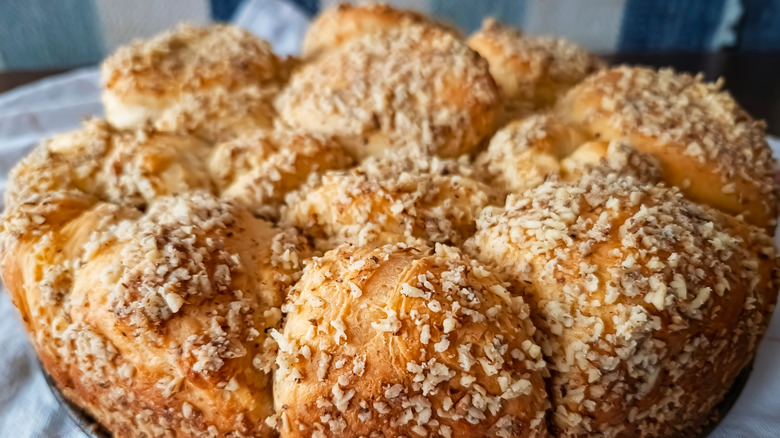Pulling apart the gooey, sugary, and doughy pieces of monkey bread is as much a tactical delight as it is one for the tastebuds — but how did monkey bread get its playful name? A perfect treat kids will love since it literally encourages messy eating with your hands, monkey bread is comprised of dough balls drenched in a slurry of butter, sugar syrup, and cinnamon, piled and baked into a ring shape.
Indisputably delicious as it is fun to eat, the exact origins of its name are a bit less clear. The dish itself, though under various different names, has been around for hundreds of years. The Americanized name of monkey bread, according to some foodies and historians, could have sprung up as a reference to the way it’s picked apart and eaten with our hands, like a monkey might. Others say it’s a nod to its shape — which looks a bit like the monkey puzzle trees of South America. Either way, the dish of cobbled-together sticky dough balls has become a beloved holiday tradition for many people, regardless of their location, culture, or what they call it.
The sticky-sweet dessert has immigrant roots
Monkey bread has been popular and widely enjoyed in America since at least the mid-20th century when it became a popular party dish in Hollywood and was later immortalized as a holiday treat by first lady, Nancy Reagan. The monkey namesake was widely used by this time, but the bread itself has roots that run much farther back. Like so many of our beloved American dishes, we have immigrants to thank. Similar to how challah was subtly Americanized after Jewish immigrants brought traditional recipes with them, Hungarian immigrants in the 1880s brought aranygaluska (meaning “golden dumplings”) to America. It was these Hungarian Jewish bakers who popularized the treat in North America where the pull-apart cake morphed into what most of us know as monkey bread today.
You’ll still see recipes for more elaborate, traditional aranygaluska prepared with dollops of jammy preserves and pecans tucked between the sticky gems of dough, zhuzhed up with bright orange zest, or embellished with crumbly dustings of sugary crushed walnuts. The more common standard Americanized version is often simpler, made with basics like dough, sugar, cinnamon, and butter. (Though you can make it with pre-made biscuit dough to save time.) It is essentially reconstituted cinnamon roll components shaped into balls instead of pinwheels. No matter how you make it or what you call it, the hundreds-year-old basic recipe makes for a delightfully sticky-sweet dessert or breakfast.






